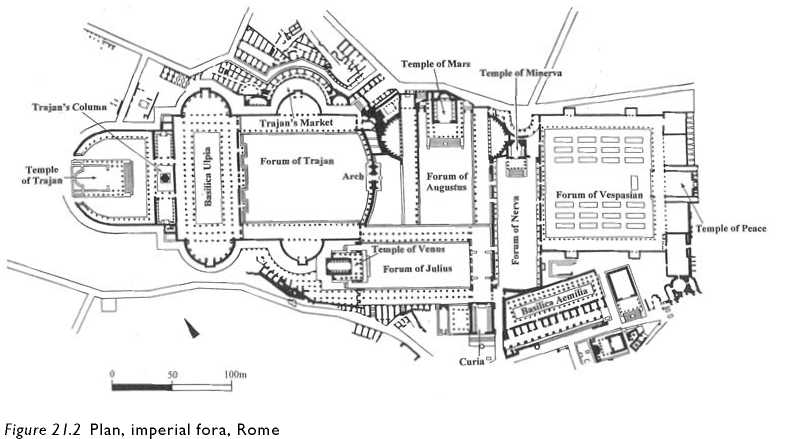The greatest architectural complex in the city of Rome during this period was the Forum of Augustus. In order to understand it, we must first backtrack to the Forum of Julius (Figure 21.2).
Julius Caesar, the dominant military and political leader from ca. 60 BC until his assassination in 44 BC, was, like Augustus after him, active in improving the architecture and services of the

Capital. In 54 BC he commissioned a monumental public square to serve as an expansion of the crowded Roman Forum. Because of its desirable downtown location, the land, purchased from private owners, was extremely expensive. The resulting Forum of Julius consisted of an open-air space lined with colonnades. A Temple of Venus Genetrix dominated the square. Julius considered himself a descendent of Venus, the goddess of love. As the mother of Aeneas, the Trojan hero and ancestor of the legendary founders of Rome, Venus was additionally venerated as a special ancestress of the Roman state. Although a temple in a colonnaded court was a Greek concept, the Greekness further emphasized by the use of marble as an elegant building material, an Italic flavor was achieved by placing the temple on a high podium at one end of the space. The temple was dedicated by Julius Caesar in 46 BC, but completed by Augustus. The Forum ofJulius was the first of a series of imperial fora, regular self-contained architectural units each planned separately, all so different from the Roman Forum which had developed gradually and irregularly over many centuries.
The Forum of Augustus builds on the concept of the Forum of Julius: a centrally located civic complex that is monumental; civilized with its Hellenic decoration; connected with the gods (by including a temple); and rich with symbolism important for the state. After his victory over the assassins ofJulius Caesar at the Battle of Philippi in northern Greece in 42 BC, Octavian (later Augustus) vowed to build a temple to Mars the Avenger (Mars Ultor). The Forum of Augustus would be the frame for the new temple. Work on the forum probably had begun by 24 BC; the temple was eventually dedicated in 2 BC, although not quite finished. Like the Forum of Julius, this forum consisted of a rectangular space (measuring ca. 125m X 90m) lined by two colonnaded porticoes. New, however, were the semicircular spaces (hemicycles) beyond the colonnaded portico, possibly unroofed spaces that brought light through the colonnades. The columns were made of different colored stone, with the fine Corinthian capitals of white marble. Like the Temple of Venus Genetrix in the Forum of Julius, the Temple of Mars Ultor, placed against the rear wall of the forum, was the focus of the broad rectangular space (Figure 21.3). Its

Figure 21.3 Forum of Augustus with Temple of Mars Ultor (reconstruction), Rome
Corinthian order establishing the Greek tone, the temple also showed traditional Italic features such as the high platform on which it stood and its frontality, with a broad flight of steps leading up to the porch.
Dio Cassius, a senator and historian of the late second to early third centuries AD, gave a detailed list of the activities that took place in this forum. Noted especially as the center for administration of the provinces, the Forum of Augustus was also the place where boys formally put on the toga, symbol of manhood; commanders sent abroad began their missions; and the Senate voted triumphs to victorious generals, and where those same victors paid homage to Mars, god ofwar, by dedicating to him their crown and sceptor of victory and captured military standards.
This forum was appropriately decorated with allusions, in sculpture, to the illustrious past of the Roman state. Subjects were carefully chosen for their symbolic value in this space so important for functions of the state. In the prominent large niche in each of the hemicycles stood statues that combined references to the founders of the Latin nation and of Rome itself: on the west, Aeneas carrying his father and leading his son out of burning Troy, and on the east, Romulus, bearing on his shoulders the trophy from the first Roman victory in the 750s BC. Other niches were filled with statues of important people, such as members of the Julian family, and perhaps a colossal statue of Augustus. Only a few fragments of these statues survive.
Inside the temple, the cult statues were apparently three: Mars, of course, fully armed as the Avenger, but with him Venus with Cupid (on his right) and the divine Julius Caesar (to his left). The pediment displayed similar figures.
Above the Corinthian colonnade sixty-two caryatids supported a second story, smaller-scale copies of the caryatids from the Erechtheion on the Athenian acropolis. For the Romans these caryatids were not merely decorative. According to Vitruvius, they represented defeated peoples, subjected in order to bring about peace. Between the caryatids were shields decorated with the heads of gods. Horned Jupiter heads, perhaps Jupiter Ammon, an important syncretistic deity of Egypt, may refer to the Roman capture of Egypt.




 World History
World History









